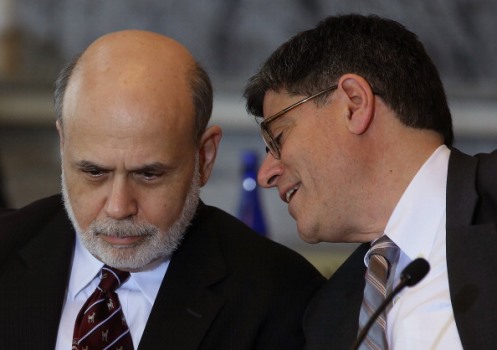Personal Wealth Management / Economics
Tricky (Central) Bank Predicaments
The Fed and European Central Bank continued policies this week we view as counterproductive to their stated aims.
Fed watchers are busy scrutinizing Ben Bernanke’s beard length for insight on future policy moves. Source: Getty Images.
Wednesday, Fed Chairman Ben Bernanke announced the central bank would maintain its pace of quantitative easing (QE) in light of moderate improvement in US economic activity. However, as we’ve detailed many times before, we view the Fed’s QE policy moves as grossly counterproductive to its stated aims.
Since December 2012, the Fed’s engaged in an $85 billion a month, open-ended purchasing program of long-term US Treasury and agency mortgage-backed securities. Many fear this program (and QE2 and QE1 before it) set the table for materially higher future inflation. Still others fear the Fed may pull the plug on QE efforts before economic growth has a stable footing. There’s chatter from both camps nearly daily in the press, citing a flick of Bernanke’s left eyebrow as evidence more easing is yet to come. Or that his recently longer, more majestic beard is a sign QE’s days are numbered. Frustrating both camps, though, was a change in Fed commentary that was somewhat cryptic and decidedly non-committal:
The Committee is prepared to increase or reduce the pace of its purchases to maintain appropriate policy accommodation as the outlook for the labor market or inflation changes.
In our view, both fears are misplaced. Data show, while the money base has certainly increased, the velocity through the economy has remained relatively slow. The vast majority of money created by the Fed’s past QE efforts were parked right back at the Fed. The Fed’s policy of paying a small, but competitive interest rate (relative to prevailing short-term rates) on excess reserves have been a disincentive for banks to lend money. What’s more, the Fed’s targeting of assets at the longer-term end of the yield curve—an attempt to push down borrowing costs for homes, cars, etc.—shrinks banks’ net-interest margins (the profit banks earn by borrowing at low short-term rates and lending out to consumers at higher longer-term rates)—a powerful disincentive to lend. In our view, that the economy continues to grow in spite of these contractionary policies is in fact a testament to its strength.
Should the Fed decide (perhaps due to economic acceleration) to ease off easing, counterintuitively, economic growth could quicken. And of course, the reverse is also possible. However, that the economy has grown despite contractionary QE existing since 2010’s QE2 on the back of corporations delivering strong top-line revenues and earnings likely suggests the economy’s overall strength continues swamping QE’s impact.
Thursday, Bernanke’s fellow central banker, ECB head Mario Draghi announced the bank would cut its main rate by 25 bps to 0.50%. (Whoa! Conventional monetary policy!) Similarly, the ECB’s marginal lending facility rate to 1.0% from 1.5%. Other ECB programs, including unlimited lending through the bank’s main refinancing operation (MRO), were left intact.
Draghi cited inflation lower than the 2% target, weaker than expected domestic and global demand and slow implementation of mostly insufficient economic reforms across the eurozone as primary reasons for the cut. In our view, target rate cuts are unlikely to have much material impact. As Draghi himself has previously stated, the ECB’s transmission mechanism—the impact its policies have on economies across the eurozone—remains broken. Borrowing rates, especially for consumers and small or medium-sized businesses in the economically weaker periphery, continue to be materially higher than those in the stronger core countries. Changes to the ECB’s target rate do little to change that.
So why cut the target rate at all? In our view, it’s likely an effort to show traditional monetary policy tools to spur eurozone lending have been exhausted. This should weaken opposition to potential future unconventional monetary policy and shift some onus onto politicians and regulators to stop attacking eurozone banks with new legislation and regulation. As we’ve said in the past, much of eurozone banks’ unwillingness to lend is rooted in risk of ongoing regulatory reforms and legislation aimed squarely at “making banks pay.” The result has been a morass where eurozone banks are forced by regulators to take less risk (via capital-requirement increasing regulation like Basel III) while simultaneously being vilified by politicians for failing to lend. A tricky predicament indeed.
If you would like to contact the editors responsible for this article, please message MarketMinder directly.
*The content contained in this article represents only the opinions and viewpoints of the Fisher Investments editorial staff.
Get a weekly roundup of our market insights
Sign up for our weekly e-mail newsletter.

You Imagine Your Future. We Help You Get There.
Are you ready to start your journey to a better financial future?

Where Might the Market Go Next?
Confidently tackle the market’s ups and downs with independent research and analysis that tells you where we think stocks are headed—and why.






